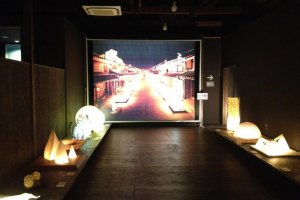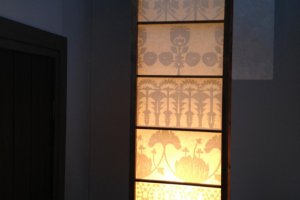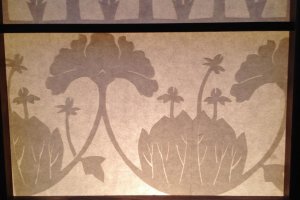Washi or Japanese paper is a delicate, painstaking and patient art of processing raw materials, and then pressing, drying, separating and cutting that can only be done effectively by hand. Those who have developed the skills don’t only make washi sheets for for commercial use but have gone on to create modern art. One encouraged and celebrated form of washi art is the “akari” art or washi lamps.
Every year in mid-October, Mino City displays washi lamp art along the main Udatsu street in the center of the city. In the off season, many of these lamps are kept in the Mino Washi Akari Art Museum just around the corner from the former Imai residence.
The museum building was constructed in 1941 and in 2005, it was registered as a Nationally-designated Tangible Cultural Property. The interior still has a 1940s feeling but has been remodeled with hinoki wood.
After showing my ticket to the reception, I proceeded to the galleries located on the second floor. The gallery is made of dark windowless rooms that have been designed to convey a feeling of an autumn evening along the udatsu lined streets. Lamps line the sides of the walls with light glowing up and out to reflect the image of the Akari Festival.
The lamps on display are made by a wide range of artists. Some are local professionals whose families have been making washi for generations while others are made by local youth who have started their journey. But the lamps are not exclusively created by Japanese nationals. Mino City hosts artists from around the world wishing to learn the art of paper making. These artists come to Mino city for a year or more to learn the trade with the goal of contributing to the lamp gallery and the tradition.
As I ventured through this gallery, I was taken by the details of print on the washi and the folds made to create complex designs. Having tried making washi once, I couldn’t imagine how much time it took to make these flowery and complex structures. When I came across one made by an 3rd grade student from an Elementary school, I was in awe of their dedication to the art and community. She had created a statue of sorts in the Nebuta style from Aomori prefecture of a woman making washi.
After leaving the gallery, you return to the first floor which includes the museum shop offering a variety of washi products ranging from basic washi sheets to lamps.
You can see washi lamps out along the streets most of the year but they are not usually lit up most evenings. If you aren’t able to make it to Mino in October, then visit the Mino Washi “Akari” art gallery to see these remarkable creations in a simulated environment. It will light your heart and mind.

































